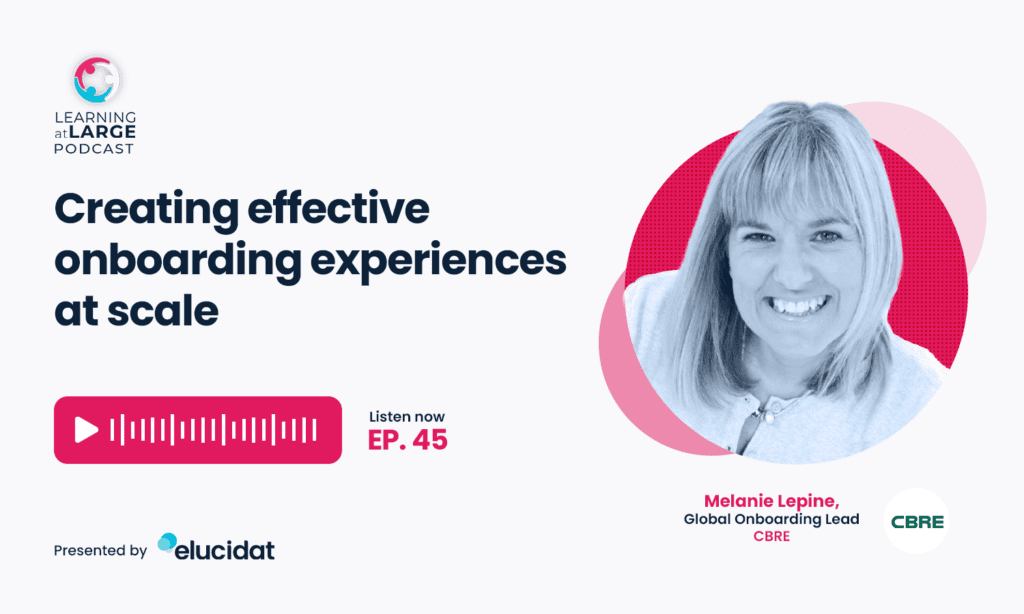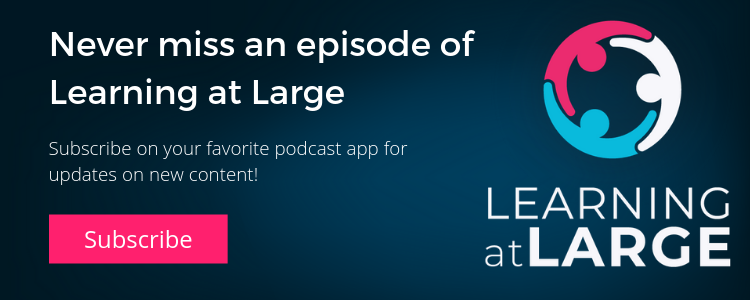Effective Onboarding At Scale: Mel Lepine
Successful onboarding can significantly improve employee engagement and retention rates. But with more than half of organizations losing new hires in the first six months, this isn’t happening. Hear how Melanie Lepine, Global Onboarding Lead at CBRE, is changing things with an effective onboarding process that works at scale, and find out how collaboration is critical to creating a sense of belonging. Explore how she gets to the real measures of success.

Top tips for creating an effective onboarding experience at scale
Don’t have time to listen now? Here are some top tips from Melanie:
- Get set up for success: Don’t rush ahead. Find out what people need and decide what approaches will deliver.
- Create a sense of belonging: Get a range of people involved in developing onboarding. Be clear on roles and responsibilities to create a consistent employee experience.
- Avoid information overload: Map out the first year of onboarding. Give people what they need in the moment, rather than everything at once.
- Measure what counts: Think about metrics from the beginning. Identify what to measure and how to get a true picture of what’s happening throughout the journey.
1. Get set up for success
Faced with increased economic pressures, budget is going to be a challenge over the next year. Businesses are asking L&D to do more with less. So, how do you prioritize what’s really going to make a difference?
For Melanie, it’s all about setting yourself, and everybody else, up for success. Working in a global organization of over 100,000 means an effective onboarding program is essential. Don’t rush ahead and create onboarding content. Find out what your people really need and decide what approaches will best deliver this.
“There were people coming in and not feeling supported in their experience in their first year of being with us. And that just felt completely wrong. Being able to come in and get to grips with how people are feeling, and what we are doing. What does the footprint look like? What does the research tell me? And then turn that into an onboarding program. So now we’ve got some tools and templates that support people. We’ve got SharePoint sites that they can go to and get information from. We’ve got communications that are reminding them of what’s available. It’s just been a really great experience to bring that to life.”
2. Create a sense of belonging
While it may be easy to get to know your manager or direct team, creating engagement and a sense of belonging in a global company can be more difficult. That’s why Melanie is working on how to create a company culture that connects people locally and globally.
This starts with getting people involved in developing the onboarding program. It means creating clear roles and responsibilities – from hiring managers to line managers. It involves connecting with talent acquisition and talent development teams, so that the new recruit gets a consistent experience.
“It’s not only been a great project because it’s going to make a difference to a lot of people but it’s how we have made sure that there are lots of people involved in it. So, we’ve got the voices of all of the people across the organization – all the different parts of the business, all the different locations in the business. They’re all having their say or helping to shape it. So, it feels like something that’s for the people, for the people rather than developed and created by a central team.”
3. Avoid information overload
When you start a new job the amount of information, you’re given can be overwhelming. So, how do you stop information overload for new recruits?
Melanie found that people didn’t necessarily understand what the onboarding process was or where they were in the process. By clearly mapping out the first year of onboarding new employees, she created a clear and consistent journey. It’s about giving people the things that they need at the moment, rather than trying to give them everything in one go.
“We had certain areas where people were getting very little communication, and we had certain areas where they were overwhelmed with communication. There just wasn’t any consistency. So, we’ve absolutely put in place some guiding principles around onboarding. This might not be a mandate. We’re not saying every single person has got to do every single piece of this, but here are the guidelines. This is what we want every new starter to feel and have an experience of when they join the business. And consistent clear communications are a part of that.”
4. Measure what counts
Don’t wait until you’ve rolled out your employee onboarding process to think about measuring your success. Metrics were one of the first things that Melanie and her team thought about.
They started by looking at the onboarding experiences that were happening, before exploring what they wanted them to be in the future. That meant focusing on overarching engagement and diving into the specific elements that they wanted to drive through the roadmap. Identifying what to measure and when throughout the journey to get a true picture of what’s happening.
“We do check ins with our new starters at multiple points throughout their first year. Right now it’s telling us a really positive story. But I don’t think that that’s necessarily a true story, because that’s only telling the story of the people that are responding. And we’re not seeing everybody respond. So actually, one of the metrics I’d like to see is for that happiness level to come down, but for the completion rate to go up.”
A quick recap
Melanie has four strategies for creating an effective onboarding program that works at scale:
- Get set up for success by spending some time finding out what people really need.
- Create a sense of belonging by involving people from across the organization in the program development.
- Avoid information overload by creating a roadmap for the first year of onboarding.
- Think about the metrics that matter from the beginning of the project.
Want to find out more about effective onboarding? Check out the full podcast.
About Melanie
With over 20 years’ experience in the people function and 15 years in L&D, Melanie now focuses on onboarding. She’s passionate about setting people up for success at the beginning of their career.
You can find out more and get connected with Melanie on Linkedin.
On Melanie’s reading list
Find out what reading has informed Melanie’s thinking in her work and personal life.
The Tipping Point: How Little Things Can Make a Big Difference, Malcolm Gladwell
Melanie is a real believer that L&D can drive change. This book helped her understand what effective change is and how to make it happen.
After seeing Professor Steve Peters make a keynote speech, Melanie sought out this book. It helped her identify how to get out of her own way in order to be successful.
Looking for more reading tips? Check out our book blog.
Join the conversation!
We’d love to hear your thoughts on our podcast, so feel free to get in touch with our podcast host, at kirstie.greany@elucidat.com. As always, don’t forget to subscribe to Learning at Large in your favorite podcast app and leave us a 5-star rating if you enjoyed it. Thank you for joining us, and see you next time.
